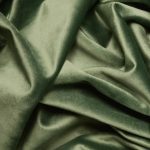When you're deciding between microsuede and leather for upholstery, you're not just choosing a fabric; you're shaping the entire ambiance of your space. Microsuede offers a soft, inviting touch, perfect for homes with children or pets, while leather brings a level of sophistication and durability few materials can match. However, each option has its unique maintenance needs and long-term value considerations. So, which one fits your lifestyle better? The answer might surprise you as you weigh the pros and cons of these two popular choices.
Table of Contents
Key Takeaways
- Microsuede offers a soft, plush surface, making it comfortable for lounging, while leather provides a luxurious and sophisticated aesthetic.
- Leather is more durable and can last for decades, while microsuede may fray or fade over time under direct sunlight.
- Microsuede is budget-friendly and easy to clean, but leather retains better resale value and requires more maintenance.
- For families with kids or pets, microsuede's stain resistance makes it an ideal choice, while leather is better for high-traffic areas.
Overview of Microsuede
Microsuede is a soft, synthetic fabric made from polyester that mimics the look and feel of real suede, offering durability and ease of maintenance. When you choose microsuede for upholstery, you're opting for a material that's not only stylish but also practical. It resists stains and spills, making it ideal for homes with kids or pets.
You'll appreciate how easy it's to clean microsuede; a simple wipe with a damp cloth can often do the trick. Plus, it's machine washable in many cases, which adds to its convenience. The fabric's softness makes it a cozy choice for furniture, inviting you to sink in comfortably.
Microsuede is also available in an array of colors and textures, allowing you to customize your space to match your style. Unlike genuine leather, it's more budget-friendly, giving you a cost-effective option without sacrificing aesthetics.
In terms of versatility, microsuede works well in various settings, from modern to traditional decor. So, whether you're reupholstering a couch or adding cushions, microsuede can elevate your space while providing practicality.
Overview of Leather
When it comes to upholstery, leather stands out as a luxurious and timeless option that brings elegance and durability to your furniture. Choosing leather means investing in a material that not only enhances the aesthetic of your space but also offers a unique feel and character. Each piece of leather has its own distinct texture and patina, adding to its charm over time.
Here are a few key characteristics of leather that you should consider:
- Variety of Types: Leather comes in different grades, such as full-grain, top-grain, and bonded, each offering varying qualities and price points.
- Natural Breathability: Unlike synthetic materials, leather allows air circulation, which helps keep you comfortable regardless of the season.
Durability Comparison
Durability plays a crucial role in deciding between microsuede and leather for upholstery, as each material offers distinct strengths and weaknesses.
When you think about longevity, leather often takes the lead. It's a naturally strong material, resistant to wear and tear, and can last for decades if properly cared for. Its ability to withstand daily use makes it a popular choice for high-traffic areas.
On the other hand, microsuede is known for its softness and comfort, but it may not hold up as well under heavy use. While it's resistant to stains and easy to clean, it can be prone to fraying and fading over time, especially if exposed to direct sunlight. However, for those who prioritize a cozy feel and are willing to replace furniture more frequently, microsuede can be a suitable option.
Ultimately, you'll want to consider your lifestyle and the intended use of the upholstery. If you value durability and plan to keep your furniture for years, leather is likely your best bet. If comfort and aesthetics are your priorities, microsuede might fit the bill, but you may need to replace it sooner.
Maintenance and Care
Proper maintenance and care can significantly extend the life of both microsuede and leather upholstery, ensuring they remain attractive and functional for years to come. Each material requires specific attention to keep it looking its best.
For microsuede, regular vacuuming helps remove dust and debris. If you encounter stains, gently blot them with a damp cloth and mild soap, avoiding harsh chemicals that could damage the fabric.
On the other hand, leather needs conditioning to maintain its suppleness. Regularly wipe it down with a soft cloth to prevent dirt buildup. You should also use a leather conditioner every few months to keep it moisturized and prevent cracking.
Consider these maintenance tips for both materials:
- Use coasters and placemats to protect surfaces from scratches and spills.
- Rotate cushions and seating to ensure even wear and prolong their lifespan.
Comfort and Aesthetics
Choosing between microsuede and leather upholstery often comes down to personal preference regarding comfort and aesthetics.
When you sit on a microsuede couch, you'll likely feel a soft, plush surface that provides warmth and coziness. Its fabric tends to be breathable, making it a comfy choice for lounging or napping. Plus, microsuede is generally more forgiving in terms of temperature; it won't feel too hot in summer or too cold in winter.
On the other hand, leather offers a more luxurious, sophisticated vibe. It's sleek and can elevate your space's style instantly. Leather has a distinct smell that many people find appealing, and it ages beautifully, developing a unique patina over time. However, keep in mind that leather can feel cooler to the touch, which mightn't be as inviting during colder months.
Ultimately, your choice will depend on whether you prioritize warmth and a casual feel with microsuede or the elegance and durability of leather. Both materials have their unique charm, so consider how each aligns with your lifestyle and the atmosphere you want to create in your space.
Cost and Value Analysis
When it comes to cost and value, microsuede typically offers a more budget-friendly option compared to leather, making it a practical choice for those mindful of their expenses. You'll find that microsuede is often significantly cheaper than leather, which can help keep your overall costs down, especially if you're furnishing an entire space.
However, it's essential to consider other factors that contribute to the overall value of your choice:
- Durability: While leather can be more expensive upfront, its durability might save you money in the long run, as it can last for years with proper care.
- Maintenance: Microsuede is low-maintenance, requiring just occasional cleaning, whereas leather needs specialized products to maintain its appearance.
Ultimately, your decision should balance your budget with your long-term needs. By weighing these factors, you can choose the upholstery material that best aligns with your financial situation and lifestyle preferences.
Frequently Asked Questions
Is Microsuede More Eco-Friendly Than Leather?
You'll find microsuede often considered more eco-friendly than leather, as it's made from synthetic fibers and doesn't involve animal products. However, its production can still have environmental impacts, so weigh your options carefully.
Can Microsuede Be Used Outdoors Like Leather?
Microsuede isn't ideal for outdoor use like leather. It can absorb moisture and fade in sunlight. If you're considering outdoor furniture, leather or specialized outdoor fabrics might be better choices for durability and weather resistance.
How Does Each Material Affect Indoor Air Quality?
When considering indoor air quality, you should know that microsuede's synthetic fibers can trap allergens, while leather's natural surface resists dust. Regular cleaning can help maintain a healthier environment with either material.
Are There Hypoallergenic Options for Microsuede and Leather?
Yes, there are hypoallergenic options available for both microsuede and leather. When choosing, look for treated materials or those specifically labeled as hypoallergenic to ensure they minimize allergens and suit your needs effectively.
What Are the Best Color Options for Both Materials?
When choosing colors, consider your space's mood. Neutrals like beige and gray offer versatility, while bold hues like navy or emerald can add drama. Always think about how the colors complement your existing decor for harmony.
- Tetron Fabric for Marine Applications: Durability and Use Cases - June 18, 2025
- Tetron Fabric for Outdoor Furniture: Weather Resistance and Care - June 18, 2025
- Tetron Fabric for Wall Coverings: Style and Application Tips - June 18, 2025







